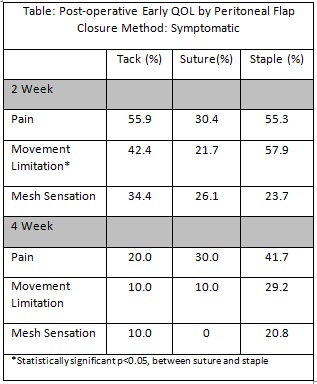Samuel W Ross, MD, MPH, Mimi Kim, MD, Bindhu Oommen, MD, MPH, Joel F Bradley, MD, Kristopher B Williams, MD, Amanda L Walters, MS, Kristian T Dacey, MHA, Vedra A Augenstein, MD, Brant T Heniford, MD. Carolinas Medical Center, Dept. of Surgery, Division of Gastrointestinal and Minimally Invasive Surgery.
INTRODUCTION: TAPP inguinal hernia repair (IHR) entails the development of a peritoneal flap (PF) in order to reduce the hernia sac and create a preperitoneal space in which to place mesh. Many methods for closure of the PF exist including sutures, tacks and staples. Given the physical characteristics of each closure type, we hypothesized that patients who had PF closure with suture had better short-term QOL outcomes.
METHODS AND PROCEDURES: A prospective institutional hernia-specific database was queried for all adult, TAPP IHRs from July 2012 to August 2013. Unilateral and bilateral patients were included and each hernia was analyzed separately. Demographics, operative characteristics, and complications were analyzed by PF closure method with standard statistical methods. A p≤0.05 was significant on the global test, and using the Bonferroni correction, p≤0.0167 was significant on the pairwise test. The main outcome of interest was QOL at two and four week follow-up, as measured by the Carolinas Comfort Scale, a hernia specific QOL tool measuring pain, mesh sensation and movement limitation with “mild, but bothersome” or greater being considered positive.
RESULTS: There were 227 patients who underwent TAPP, with 99 bilateral and 128 unilateral IHR, for a total of 326 IHR. PF closure was performed using tacks in 45.1%, suture in 19.0% and staples in 35.9%. Patient characteristics were statistically similar between the tack, suture, and staple group: age (54.3±14.7 vs 54.0±13.9 vs 51.2±15.4), male (95.9% vs 83.9% vs 94.9), BMI (26.4±4.4 vs 26.6±7.4 vs 26.0±3.3 kg/m2), smoking (2.7% vs 9.7% vs 5.1%), incarcerated (17.7% vs 14.5% vs 23.9%), pre-operative pain (57.1% vs 50.0% vs 71.0%) and movement limitation (44.1% vs 40.9% vs 57.1%). There were 32.9% direct, 46.5% indirect, and 20.6% pantaloon hernias, which were not significantly different by PF closure method. Post-operative complications and length of stay were same for the three groups. There were no hernia recurrences. QOL outcomes are presented in the Table. Post-operative movement limitation at two weeks was significantly better in the suture group when compared to the stapled group (p=0.006). Additionally, sutured PF closure had less early post-operative pain when compared to the tack group but this lost statistical significance with the Bonferroni correction (p=0.038)
CONCLUSIONS: Following TAPP IHR, suture closure of the PF significantly improves 2 week post-operative movement limitation compared to stapled PF closure. Although not statistically significant, the suture group had a trend toward better early post-operative pain, movement limitation, and mesh sensation when compared to tack and stapled PF closure methods. Continued prospective studies are needed to determine the best surgical hernia repair methods for ideal post-op QOL.
